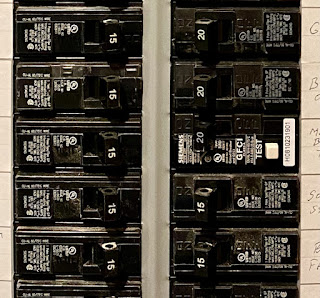I've been doing some serious electricity power monitoring at my house to see how I can reduce my electricity consumption and costs.
I have an 8-sensor Emporia Vue home electricity monitor and a Kill-o-Watt power meter, so I'm well equipped to identify what is chewing down the electricity I pay for.
When I first installed my Emporia Vue, I found that my house was always consuming at least 128 watts of power. I'll call this my house's base load. What made up these 128 watts? Phantom loads? Let's Discuss!
Phantom Load or Not?
A phantom load, by one definition, is equipment that is always consuming some electricity even though it is not in active use. This is commonly understood as "standby power consumption". But another definition of phantom load is equipment that is inexplicably consuming significant power for no known useful reason. We might call this "completely stupid power consumption".
I had both types: standby power and crazy-off-the-charts useless power waste.
My AC unit was always eating at 45 watts. My furnace had thermostatic heat tape that was always using 10 watts. Why? No idea. All together, these two phantom loads were using 482 KWh a year, or 4.820 MWh in a decade. 4.8 Megawatt-hours is a very, very substantial amount of beer money.
On the other hand, my basement HVAC is always consuming 3 watts, but it is always on standby ready to be automatically called into service. The HVAC consumes standby power, but I'd be hesitant to call it a problem as heat is an essential home service where I live and its power draw is reasonable by today's standards.
Essential Equipment Base Load
My first question is: What is the power consumption of the essential equipment in my home?
I consider essential equipment to be equipment that is
traditionally considered part of the building and is necessary for the
building and its occupants. This includes HVAC, major appliances,
security and safety equipment, sump pumps, and (these days) basic
networking gear. Being "base load" means that this equipment is on standby, but it isn't running. Therefore, the essential equipment base load is the bare minimum power my house will use, even if no one is occupying the house.
Safety Systems: 20.8 Watts
- Security System: 9.8 watts. A Honeywell Vista 20P alarm system with many smoke detectors.
- Carbon Monoxide Detectors: 3 watts. I have three Kidde CO units at ~ 1 watt each.
- Breakers with GFCI/AFCI: 6 watts. I have 12 breakers with these features at ~ 0.5 watts each.
- Outlets with GFCI: 2 watts. I have 4 GFCI outlets at ~ 0.5 watts each.
Data communications backboard: 20.6 Watts
This is all my networking gear: WiFi access point, Internet gateway router, PoE switch, Ring doorbell system, whole-home TV tuner, and Apple TV. This equipment, attached to my basement networking backboard, provides what I consider essential home network services. They collectively account for 20.6 watts of power total.
Appliances: 12.3 Watts
Some appliances are always on, even when idle. Here's what I have:
- Refrigerator: 3 watts. Its electronic control system is always on.
- Kitchen Range: 7.3 watts. Stupidly high. It just has a clock that's on while idle. Gr.
- Dishwasher: 1 watt. It has a digital control panel, so it is always eating some juice.
- Clothes washer: 1 watt. Again, it has a digital control panel, so it is always doing something.
- Clothes dryer: 0 watts. It is old-school and consumes nothing while idle.
HVAC: 10.8 Watts
I have two
units, both with Ecobee 3 lite thermostats. When they're in standby mode, the two HVAC systems
collectively consume 10.8 watts of power. (I flipped off one of the two (dissimilar) outdoor AC units, as it was stupidly consuming 45 watts all the time, and I removed always-hungry heat tape. WTF?)
Other Items: 4.8 watts
- Raspberry Pi Zero (home server): 0.8 watt
- Meross WiFi home automation light switch: 1 watt
- Emporia Vue energy monitor: 3 watts
Total Essential Base Load: 72 Watts
Adding all these devices together and I get about 69 watts, which matches my typical low-water mark reported by my Emporia Vue of 72 watts. Multiply that by 8766 hours and a year and we get 640 KWH used power year. That's still substantial beer money, but I can't see a way to easily reduce that number.
What isn't included
This 73 watts of "essential base load" doesn't include any of the following that is normally install by the occupier, and it doesn't include equipment that isn't always plugged in.
For example, these items are not included:
- Home automation "smart" outlets
- Wall powered plug-in alarm clocks
- TV or radios
- Phone chargers
- Computers, printers, etc, except for essential home equipment noted above
- Any equipment doing any real work (HVAC, Fridge, Dishwasher, etc)
- Any lighting
- Basement dehumidifier, which I have on standby seasonably (basically from late spring to early fall)
So this 73 watts is the bare minimum load of the essential building devices for any minute of the year.
Next Steps
In a future article, I will add up my "occupier equipment base load". This will include idle home equipment like device chargers, printers, TV, and so-forth. Think of this next number as the power consumption of all the clocks and TVs and stuff that people move in with. Stay tuned.
